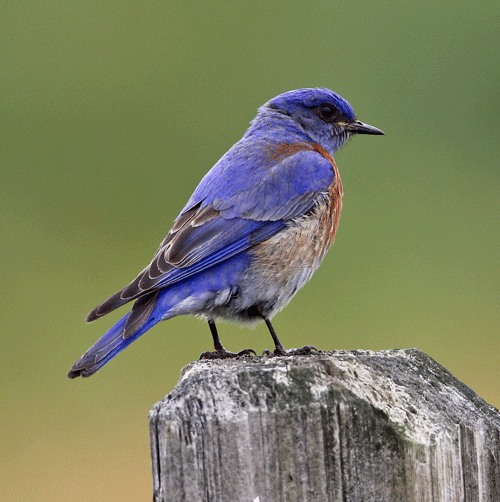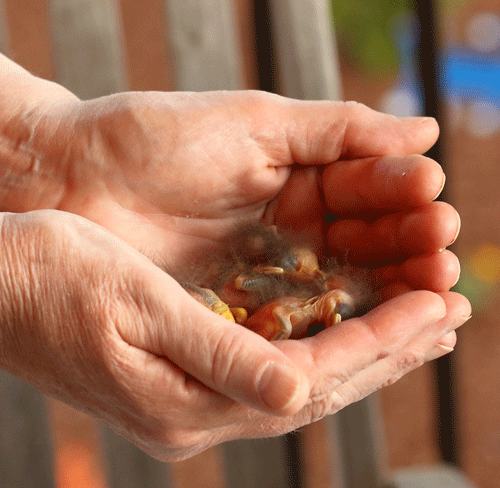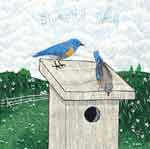Atop the Nest Box
Special Bluebirds and Their People

The 2010 nesting season began with unusually cold and wet weather, causing many broods to fail. In fact, it was so severe that some adult birds perished, mainly hens who had the added physical stress of laying and incubating. As a result, we had a record high number of ailing and orphaned nestlings to care for. This phenomenon affected the entire Willamette Valley.
In late July, I received a call from Patrick Gallagher of the Salem Audubon bluebird group. One of the landowners on his trail had three orphaned nestlings about 12 days old. They were healthy and only needed a pair of foster parents, which Patrick could not provide. As it turned out, I had the perfect situation. There was a pair of bluebirds on my trail that had been unable to produce offspring for the last two years. Being altruistic, this pair had just finished raising three orphaned nestlings from elsewhere on my trail. I quickly met with Pat’s landowner and she handed over the new orphans.
Mr. and Mrs. Altruism were delighted to receive more foster children. The following day I returned to band the new nestlings and was delighted to see that one of the previous orphans was helping feed them. Talk about paying it forward! The Salem orphans fledged uneventfully and the adult pair remained on or near their territory with all of their foster children throughout the fall and winter.
At the end of the 2010 nesting season, having worked us hard, Mother Nature gave us a precious gift. Pat’s landowner, having several nesting pairs, notified me of her last brood of the season in the hope that I would band them. Prepared to band her four nestlings, I met with her at the site. As I reached into the nest, I noticed that one of the chicks was rather pale. We examined it more closely while banding, and concluded that it was leucistic (partial albino). With decades of combined bluebirding experience, this was a first for both of us, and we were honored and humbled by the gift that nature had bestowed on us. After the brood fledged, the landowner described the leucistic fledgling as looking like a pale cloud as it flew. We referred to it as “Ghost Blue.”
~ Raylene Gordin
When Bluebirds Fight, Bet on the Bluest

Among male Eastern Bluebirds, their blues, along with bird-visible ultraviolet colors in their plumage, give a pretty good indication of which males make the toughest competitors, according to a study of nesting birds by Lynn Siefferman and Geoffrey Hill of Auburn University in Alabama.
In some birds, the feather pigments signal the health of a mate. The bluebird blue, however, poses new questions because it doesn’t come from a pigment. Instead, the color is a trick of the light bouncing off intricate structures on feathers. Researchers have wondered whether such structure-based color could also signal the fitness of a male.
The researchers set out birdhouses and watched to see which males triumphed in competitions to take up residence there. Feathers plucked from the winners turned out to have more-intense structural coloring than the losers’ did. The more colorful males also successfully raised more offspring. Thus, the color could be an indicator of which bird to wager on in male-male competitions, the researchers report in an subsequent article in Animal Behaviour 69(2):387-394, February 2005.
~ Andrea Foster
Think BLUEBIRDS!

Granted it’s been raining for days on end, but the bluebirds haven’t let it stop them. Several calls have come in to remind us that the season is close at hand. Carole Steckly’s friend, Alma Davis, who lives off of Rt. 34 across the Willamette, has had bluebirds inspecting her nest box three years in a row, but the swallows and accipiters have discouraged them from nesting. Three males were seen last week, another this week. These are probably migrant birds headed to Washington and British Columbia. This is the time of year when I get these calls.
Earlier on the Christmas Bird Count fifteen were seen in the oaks on the “Thompson” Greenbelt property. The CBC total of 146 was a reasonable tally. More recently Don Boucher saw 9 flying overhead while at of Jackson-Frazier Wetland. Vi and Clarence Omoto see four from the last brood of 2003 hanging around near their feeder in a NW Corvallis neighborhood. Kristy Kingery feeds nine or more at her feeders and tells me that the one flock (and their friends, the finches) chased off another brood trying to muscle in on the good deal. She can’t believe that the pair trying to copulate is really in earnest! Too soon to practice with April and May months away.
However, my message should be loud and clear. When the weather blesses you with blue skies and sunshine, please go out to check all of your boxes including the ones other birds nested in. After very cold temperatures and heavy snow such as we had a month ago, birds that have sought shelter in the nest boxes may have perished there. If you find any, banded or unbanded, please bring them to me. Go prepared with something to clean out the box (don’t reach in bare handed because queen yellow jackets like these boxes too), plastic baggies, a few tools and a new box “just in case.” Close all cracks and crannies with weather stripping knowing that it may rain through May when eggs or chicks are in the boxes. NW weather is deadly for early breeding birds.
I have a few new boxes you are welcome to have. We also have four already mounted on pipe that can be placed over a long piece of rebar which has been pounded into the ground. I plan to carry on with banding and checking some boxes; I’m always available to answer questions and make suggestions. I would appreciate it very much if you could enlist others in you neighborhood to get interested in our Blue Bird Trail. We can always use more volunteers.
Nest box monitors, please check Reminders. I’m anxious to hear from all of you!
~ Elsie Eltzroth
Quilt Square Honors Willamette Valley Bluebirds

Recently we learned that Audubon Society of Corvallis Bluebird Trail was honored by one of our dedicated and hard working volunteers. Members of Consumer Power Incorporated (CPI) were asked to submit squares for a celebratory quilt to recognize the cooperative’s 50th Anniversary. Rita Snyder submitted a square depicting a pair of bluebirds on a typical nest box. Her square was one of 50 accepted for inclusion for the quilt. A picture of the CPI celebratory quilt was featured in the October 2003 newsletter, The Ruralite.
The handiwork of the quilters was to “create blocks depicting their rural heritage, rural electrification, local landmarks or scenes” that were significant in their lives. Rita choose the return of the Western Bluebird. Rita and her husband, Bill Snyder, have been hosting pairs of Western Bluebirds in boxes on their Crescent Valley Drive property since 1988. The Snyder’s nest boxes, now numbering eight, have fledged 269 young bluebirds. Their contribution has made a tremendous difference in the local population of bluebirds which have returned to the Willamette Valley year after year.
~ Elsie Eltzroth






